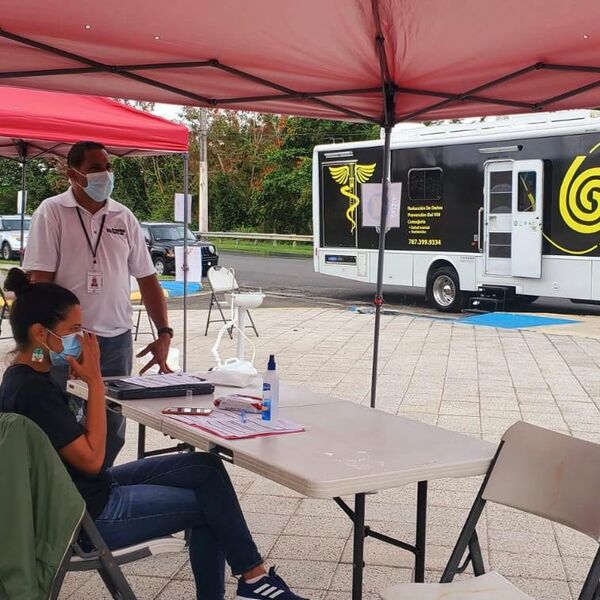
Project Overview
Overview of Project and Funding
Even the most informal harm reduction programs provide some dimension of service navigation. Harm reduction program staff use their experience and relationships to mitigate common barriers that limit people's ability to access and receive care. For example, every time they recommend a pharmacy known to sell syringes without a prescription over one with more restrictive policies or offer a warm handoff to a familiar, culturally competent medical provider instead of a general office number, SSP staff and participants build trust, which increases interest, comfort, and openness to accessing further care.
Our funded programs described many factors that can discourage or actively prevent PWUD from successfully accessing and benefitting from locally available medical and social services, for example:
- Stigma from providers and office staff
- Complicated appointment-making processes
- Insufficient public transportation networks
Building responsive and sustainable pathways to comprehensive care requires:
- Well-equipped staff
- Active collaboration with local service networks, and
- The flexibility to pursue innovative participant engagement strategies
Through this project, we found that though many SSPs are eager to provide navigation to their participants, dedicated and flexible funding for such programs is rare. This means that much ongoing SSP-based navigation work goes undocumented and without the opportunity for monitoring, evaluation, quality improvement, and sharing of best practices.
With support from CDC cooperative agreement PS19-1909 and in partnership with AIDS United (AU), NASTAD worked with eight SSPs to implement comprehensive patient navigation services for PWUD, representing one of the first federal funding opportunities intended to provide direct support to SSPs. Each site was awarded $100,000 in Year 1 and $65,000 in Year 2.
A primary participation requirement was that the program must have an operating SSP that did not already utilize a formal navigation program. The project scope initially focused on connections to prevention and care for infectious diseases and MAT (medication-assisted treatment, or medications for opioid use disorder, MOUD); given the significant role that the social determinants of health play in addressing health and safety needs and providing stability, navigation quickly expanded to include a broader array of social and governmental services, including securing birth certificates and personal identification. These administrative steps were often necessary precursors when pursuing SUD or infectious disease care: for people recently released from jail or prison and people experiencing housing instability, the lack of a state identification, birth certificate, or social security card is a significant barrier to health insurance enrollment, public benefits enrollment, housing, and other services.
Funding Details
This microsite is the result of a two-year project funded by US Centers for Disease Control and Prevention (CDC) cooperative agreement PS19-1909 Component 1a: Patient Navigation Programs at SSPs Demonstration Project, which supported the implementation of patient navigation services for people who use drugs in existing harm reduction programs. Additional funding made available under OT18-1802 – Strengthening Public Health Systems and Services through National Partnerships allowed the demonstration project to continue beyond the first year of implementation and enriched the overall project outcomes.
Identified goals of the Patient Navigation Demonstration Project included:
- Development of patient navigation programs at up to eight SSPs to link clients to medication-assisted treatment (MAT, or medications for opioid use disorder, MOUD) and to prevention, care, and treatment services for infectious disease;
- Development of a system to track navigation, provide support and technical assistance (TA), and document project outcomes; and
- Development of guidance on best practices for patient navigation.
The NASTAD Drug User Health team, with support from AIDS United, was responsible for designing and conducting a competitive RFP process that included peer and staff review for selection of sites and creation of project overview and orientation materials. Project staff were also responsible for executing project deliverables and providing technical and capacity building assistance to project sites. Program activities began at selected sites in March 2020 and concluded in June 2022.
Impact of COVID-19
The ability of SSPs to implement and reorient patient navigation services during a global health emergency is a testament to the tenacity, ingenuity, and humanity of not only participating staff but harm reduction workers everywhere.
Amid the immense challenges of the pandemic, the need for comprehensive patient navigation became even more pronounced and urgent as people who use drugs worked to protect their health and access services in overwhelming and unpredictable circumstances.
The onset of the COVID-19 pandemic drastically altered nearly every aspect of patient navigation and the programs and communities in which projects were implemented, including but not limited to opportunities and conditions for participant engagement and relationship building, healthcare priorities and needs, service availability, transportation access, housing, the drug supply, staff turnover, and social support. SSPs, like other direct service providers in the early weeks and months of the pandemic, sought to continue delivering services while developing safety protocols for staff and participants. Many programs experienced increased demand for supplies and support, including those unrelated to drug use (food, water, shelter, hygiene supplies, pandemic-related information, etc.). Programs supported through the project adapted by limiting indoor/fixed site services such as offering appointment only, moving services outdoors, and switching to a “drive-up” or delivery model for distributing supplies.
Regular contact between sites and NASTAD/AU TA staff provided a critical information-sharing and feedback mechanism to project staff and funders on implementation, necessary changes to scope and approach, community wellbeing and emergent needs, and policy changes. Of particular importance were evolving policies around accessing medications for opioid use disorder (MOUD), for example the use of telehealth services for buprenorphine induction and to treat existing patients with buprenorphine and methadone, and increased flexibilities around receiving take-home doses of methadone. Check-in calls open to all project sites offered a space to share promising strategies, support, and solidarity, and many staff from participating programs contacted each other directly for peer TA and connection.
Some outcomes and recommendations shared here are specific to activities and services performed during the COVID-19 pandemic but may be instructive when providing drug user health and harm reduction services during other public health crises.

Intercambios and the Impact of COVID-19
In March and April of 2020, Intercambios was in communication with the Puerto Rico Department of Health to secure designation as an essential service, allowing the SSP to continue operating as critical infrastructure. As government and social services shifted primarily online (for example, Medicaid enrollment), the Patient Navigator prioritized facilitating access to these services for participants, many of whom did not otherwise have internet access. Changes to the MAT service landscape, such as reduced hours and stricter policies/additional requirements, challenged participants’ ability to access treatment, avoid withdrawal, and stay well. With prescribed buprenorphine less available, diverted buprenorphine became more expensive, and Intercambios became aware of participants presenting at the hospital in severe fentanyl withdrawal. While working to understand shifting MAT policies and navigate participants to treatment, Intercambios also provided education and resources for managing withdrawal and undergoing self-detox.
When COVID-19 vaccines became available, Intercambios played a crucial role in ensuring access for PWUD and the other marginalized people they serve in eastern Puerto Rico. They had previously partnered with Direct Relief, which provided free personal protective equipment, and Doctors Without Borders, who trained staff in COVID safety protocols. In April 2021, Intercambios collaborated with the Department of Health and CDC to host their first vaccination event for SSP participants. During the 15-minute observation period after vaccine administration, Intercambios offered overdose prevention education and naloxone. Because of their trusted connections with communities of people who use drugs, Intercambios was in communication with “shooting gallery” leaders to spread the word about vaccination events and encourage participants to attend.
Project Data Collection and Analysis
Throughout the project period, NASTAD required each program to collect and report quantitative and qualitative data related to patient navigation activities on a quarterly basis. NASTAD held monthly TA calls with each program, coordinated quarterly group calls for all sites, and hosted a series of listening sessions on priority issues emerging from the project. Technical assistance was offered where necessary to assist programs in developing data collection tools and practices. NASTAD synthesized information from the multiple data sources mentioned above to distill key lessons learned and develop guidance for SSPs interested in implementing or expanding patient navigation.
Examples of data collected and reported, where and when reasonable, include:
- In aggregate:
- Number and demographics of SSP participants engaging in patient navigation services (demographics refers to age, sex, race, ethnicity, drug use characteristics (primary drug of choice), and any known HIV/HCV status
- Number and demographics of SSP participants who initiated referral to care/treatment for infectious disease and MAT through patient navigator(s) and number and demographics of participants that completed linkage to each service
- Other types of navigation requested and received
- Anonymous, de-identified process data (when appropriate and not at risk for identifyingparticipants):
- Patient navigator action (e.g. did they provide information about a referral, did they set up an appointment, did they take the participant to an appointment?)
- Key dates when actions occurred (date of initial request, date of navigator action, etc.)
- Qualitative data on program implementation challenges, successes, participant-level barriers, promising strategies, and participant case studies
Note on Data Reporting and Limitations
To represent the actual conditions and experiences of patient navigation provision, data reporting was mostly limited to the usable information SSPs might ordinarily collect for internal records and program evaluation. The data collected across the eight patient navigation sites were self-reported and self-categorized, leading to variations in data collection and reporting. Sites were asked to provide quantitative data on patient navigation enrollments, MAT engagement, and HIV/HCV testing and linkage to care. However, other reporting categories, such as housing support, immunizations, and ID services, developed as the project progressed and were not standardized, leading to variations across sites. It is possible that sites provided additional services to participants and did not report data due to inadequate administrative support, fluctuations in staff capacity, and overall reporting burden. Therefore, the data presented in this report is meant to be a snapshot of services provided by patient navigators and sites.